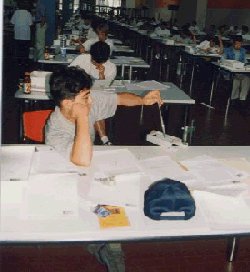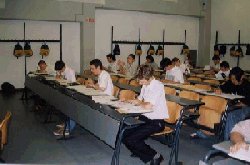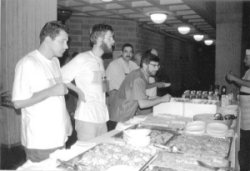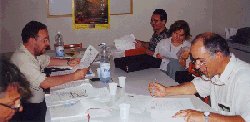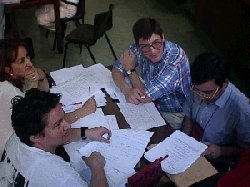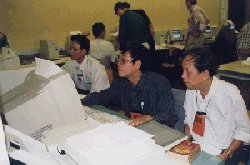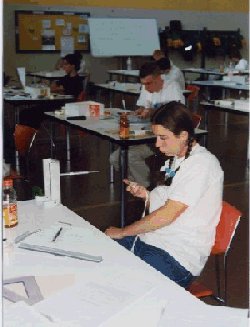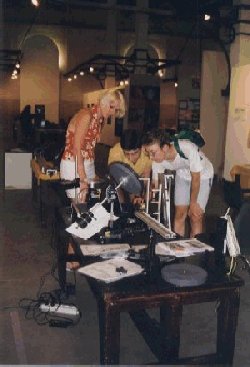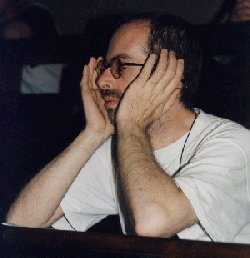The history of Superconductivity dates back to 1911, after the first liquefaction of helium. Superconductivity is a termodynamical state of matter, which occurs in most part of the metal elements and in a great number of compounds, when cooled down to very low temperatures.
Materials in the superconducting state display a set of interesting properties such as zero dc electrical resistivity, perfect diamagnetism, and very low surface resistance for AC currents.
Two main applications of Superconductors, i.e. superconducting magnets and superconducting accelerating cavities, are in the field of particle accelerators. Magnets are used in order to bend particle beams in circular accelerators while cavities are the elements that give energy to the beams.
A resonant cavity is an electromagnetic energy-storing device, where electric and magnetic fields would oscillate till all the energy is dissipated because of the finite conductivity of the walls.
If a superconductor is used as the wall material, the decay time (proportional to the so-called Quality Factor "Q" of the cavity) can be increased by six orders of magnitude. The other characteristic figure of a cavity is the electric field available for the acceleration of particles (Eacc). Superconductors make it possible to reach accelerating fields of the order of several tenths of MV/m.
Primarily two different solutions are currently recognised as being promising for the achievement of high accelerating fields at low power losses. A more traditional approach involves the improvement of bulk Niobium resonators, while a less classical solution is the development of Niobium sputtered oxygen-free Copper resonators.
At the Superconductivity Laboratory of LNL work is underway to improve on both these two routes.
Traditional bulk niobium cavities are usually made by spinning half cells and subsequently joining them by electron beam welding, which is a costly and time consuming process.
By means of a patented spinning technique, at LNL seamless cavities have been produced, which performed at the top of the present technology levels, with a very substantial reduction in production time and cost.
The spinning technique is a cold deformation process, starting from a circular blank or a tube, for the creation of complex shapes with cylindrical symmetry. It allows producing a ninecell cavity in a day instead of a month, with a factor twenty of cost reduction.
The laboratory is engaged in the production of prototypes with the aim to install them in the TESLA TEST FACILITY in Hamburg.
The other way of producing a superconducting resonator is to coat the interior wall of a copper cavity with a thin superconducting film deposited by sputtering. This brings several advantages, namely material cost savings, a better thermal and mechanical stability of the resonator, and the possibility of investigating different coating materials.
Niobium is not an easy material to sputter, since its superconductive characteristics depend sensitively from even a small amount of contamination. The sputtering of niobium films inside a Copper resonator is one of the last steps of a long procedure. After mechanical forming the copper substrate is barrel finished up to a roughness below 0.1 mm. Then it is ultrasonically degreased in an alkaline bath and ultrasonically rinsed. It undergoes bright dipping, rinsing, elecropolishing, 100 bar ultrapure water rinsing, chemical polishing, surface passivation, 100 bar ultrapure water rinsing, ethilic alcohol rinsing, nitrogen drying. The resonator is then displaced in the sputtering system, and pumped down to a vacuum in scale of 10-9 mbar after at least 24 hours of baking at 250°C.
After having sputtered the Niobium film the resonator is mounted into a test cryostat and cooled to 4.2 K or 1.8 K, depending on the type of cavity.
The radiofrequency measurement takes place monitoring the quality factor Q versus the accelerating field Eacc.
Three types of sputtered cavities are presently handled in our laboratory, finding themselves into three different stages of development. The quarter wave resonators (QWR), used in the ALPI linac, are in a full production stage, and work is going on to replace the old lead plated cavities with the Niobium sputtered ones.
TESLA type monocell resonators are currently sputtered and tested. The best result up to now is in the average of a group of similar cavities prepared at CERN. Work is going on, pointing at the realisation of a ninecell niobium-sputtered copper cavity.
The Superconducting Radio Frequency Quadrupole resonator (SRFQ) is the most recent type of Niobium sputter-coated resonator we are investigating. Required for injecting low beta (v/c) ions from the source to a superconducting linac, it has a rather complicated structure. Preliminar depositions on small quartz samples in a dummy steel cavity have been carried on with success, and the construction of a copper substrate prototype is presently considered for the successive steps of the program.
Besides these activities, the laboratory is also actively investigating the sputtering of new superconducting materials in order to replace Niobium with a higher performance superconducting compound.
As a conclusion, a new type of nuclear and subnuclear physics asks for a new technology, new devices with higher performances at lower costs. The radiofrequency structure is the heart of a superconducting accelerator and, for the particle accelerator community; new RF structures serve as a strategic tool. The sputtering technique is a valid alternative to bulk Niobium technology for high performance resonators.
|
|









|
|
Spinning of a 1,5 GHz copper monocell from a circular blank.
|
|
Presently the Legnaro accelerator complex consists in a XTU tandem followed by the superconducting linear booster ALPI. It delivers ion beams to the experimental rooms with beam intensities on the target of few particle-nA, masses ranging from protons to masses of the order of 100 amu (81Br) and energies well above the Coulomb barrier as it is shown in figure 1. The main constraint for the existing facility is the presence of the stripping section inside the tandem that limits the performance of the accelerator complex towards the heavier masses, up to 200 amu, and the beam intensities. On the other hand the nuclear physicists are interested to the very heavy ion beams with energies around the interaction barrier.
As a consequence of this request a new injector for the ALPI booster has been proposed at the beginning of 1996. The injector PIAVE ( Positive Ion Accelerator for Very-low Energy ) is meant for increasing the mass range of the facility up to lead ion. PIAVE will use the beams generated by the ECR Ion Source Alice placed on a high voltage platform operated at 350 kV.
The construction of a positive ion injector for the linac ALPI, named PIAVE, at Laboratori Nazionali di Legnaro was funded in 1996. The injector, consists of two Superconducting Radio Frequency Quadrupoles (SRFQ) and eight superconducting Quarter Wave Resonators (QWR) for an equivalent voltage of about 8 MV (U28+ beam). The building is ready; infrastructures and beam transport lines are being installed. The superconducting RFQ's are in the construction phase.
|
|
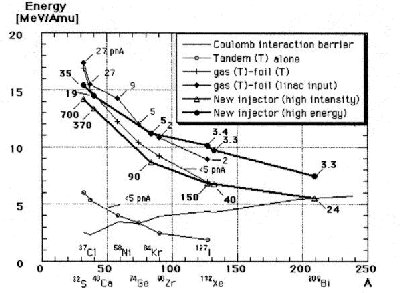
|
|
Figure 1: Performances of the Legnaro accelerator complex including the foreseen upgrading given by PIAVE.
|
|
Figure 1 describes the performance of the tandem-ALPI complex and compares it with the foreseen capability of PIAVE in terms of specific energy of the beam versus the mass number. The values indicated near the curves are the beam currents on the target, in particle-nA, including a realistic transmission coefficient in ALPI of 50%. It clearly shows the possibility of reaching the heaviest masses keeping the energy of the beam above the Coulomb barrier and with beam currents on target more than adequate for nuclear physics experiments.
PIAVE is a superconducting linac operating at a rf frequency of 80 MHz and containing two SRFQ resonators followed by eight QWR's. It accelerates beams from b=0.0089 to b=0.045, in the case of a +28U238 beam, for an efficient injection into ALPI. The cavities are located inside three cryostats: one containing the two SRFQ and two, similar to the ALPI ones, containing four QWR's each.
The accelerator is connected to the ECR source, placed on the high voltage platform, on one side and to ALPI on the other side by matching lines containing the bunching systems to perform the longitudinal matching of the beam. The beam dynamics analysis of the whole system is completed and the various component of the matching lines are in different phases of construction.
|
|
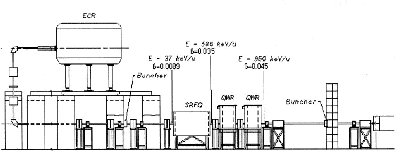
|
|
Figure 2: The Layout of PIAVE
|
|
Figure 2 shows the layout of the machine, including the ECR high voltage platform.
The high voltage platform housing the ECR source is placed on a concrete base and its output beam line and accelerating column is displaced, both vertically and horizontally, with respect of PIAVE. The resulting transport line deflects the beam of 180° guiding it on a line some 5 meters below and some 2 meters to the left of the ECR output one, following the beam direction. All the magnetic elements of the line were ordered.
The beam analysis is performed by a magnetic spectrometer on the high voltage platform. Therefore the magnetic elements of the line are meant only for the transverse matching of the beam into the SRFQ's and to create the required beam waist at the buncher location.
The beam dynamics studies determined the need for a very efficient bunching system with a low transverse emittance increase. The result of that is a quite innovative design of a triple harmonic buncher realized with two independent cavities ; the two cavities operate at 40-120 MHz and 80 MHz respectively.
The buncher, combining the absence of grids and the use of three harmonics, has a bunching efficiency of »68% and it requires a rf power of less than 100 W which allows the use of a room temperature system without severe cooling problems. The cavities are powered by three independent solid state amplifiers controlled by standard ALPI rf controllers. The operation of the first cavity at 40 and 120 MHz is possible due to the different field distribution of the two modes with a careful displacement of the tuners, the couplers and the pick-ups.
In the beam velocity range 0.009 £ b £ 0.035 the acceleration is performed by two SRFQ resonators operating at 80 MHz and made of niobium sheets electron-beam welded. The accelerating structure of -2.5 meters long is split into two different resonators housed in the same cryostat. This choice is dictated by the limitation in the maximum storable energy inside a cavity compatible with the rf phase locking.
The novelty of the project, with respect of similar facility already operating in other laboratories, is the presence of the superconducting RFQ The beam dynamics specifications, the bunching of the beam, which is made before the RFQ with a triple frequency buncher described above, and the particular care put in the design of the cavity both for rf and vibration control reasons are the main peculiarities of the SRFQ design. The complete design of the SRFQ resonators is almost finished and the first stainless steel prototype is in its final construction stage.
The accelerating structure is changed, passing from the SRFQ to the QWR, following the indications of the beam dynamics studies at an energy of 578 keV/u, that means b=0.035 for the nominal uranium beam mentioned above. This beam velocity is too low for the injection into ALPI low b resonators. Therefore a section containing eight QWR's with an optimum b of 0.047 is foreseen for PIAVE. These cavities are similar to the ALPI ones and the first example is now under construction following the production procedures fixed for the ALPI resonators.
The matching line between PIAVE and ALPI contains two quadrupole triplets, an achromatic 90°, made of two bending magnets with a quadrupole singlet using the standard ALPI'L-Bends', as well as two room temperature bunchers.

